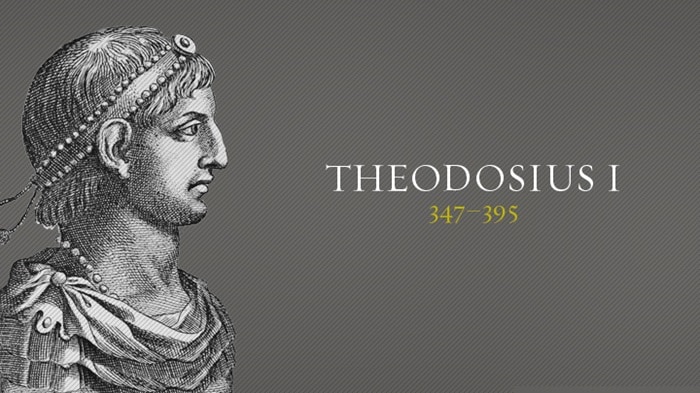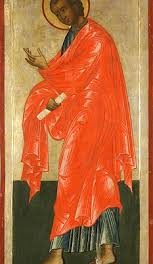This episode of CS is titled, “Syncretism.”
Recent episodes have chronicled the growing rift between the Eastern church centered at Constantinople and the Western-based in Rome. At the Council of Chalcedon in 451 Eastern bishops elevated the Bishop of Constantinople to near equal status and authority with the Bishop of Rome, giving the Church 2 heads. It was increasingly obvious politics played a greater role in church affairs than the quest for doctrinal purity or faithfulness to the Gospel–mandate. East & West were moving in opposite directions.
Since Constantinople as the “New Rome” was the political center of the empire the Eastern church grew increasingly linked to Imperial power. In the year 380, on Feb. 27th in his Edict of Thessalonica, Emperor Theodosius declared Christianity the official state religion and banned paganism. Since the Church had no authority or power to enforce compliance to the Faith or to punish unconverted pagans, Imperial power was lent to enforce the Emperor’s will.
This forced-conversion of vast multitudes of pagans saw an influx of new church members whose commitment to the Gospel was doubtful. Priests were now in the uncomfortable position of having to lead people they knew were at best, only nominally-committed.
Since the Christianity of the 4th C had moved away from its roots in Judaism with its knee-jerk hostility to idolatry, a growing number of priests, who’d themselves been idol-worshiping pagans before conversion, though it might facilitate the assimilation of new converts to the Faith if concessions were made to the old forms. Why not take age-old traditions and direct them toward new ends? The veneration of angels, saints, relics, pictures, and statues was an attempt to bring ex-pagans into a more familiar form of worship and accommodate their religious sensitivities. Of this process, Philip Schaff writes, “The Christianizing of the State amounted in great measure to a paganizing and secularizing of the church. The world overcame the Church, as much as the Church overcame the world, and the temporal gain of Christianity was in many respects canceled by its spiritual loss. The mass of the Roman Empire was baptized only with water, not with the Spirit and fire of the Gospel, and it smuggled heathen manors and practices into the sanctuary under a new name.” [1]
It’s a risky venture attributing motive to those removed from us by such a long distance in time, but I suspect for many church leaders the assimilation of pagan forms into the liturgy of the Church was seen as a necessary concession to the large numbers of barbarians now required to convert. The hope was that as these new, nominal church members learned the Gospel, the truth would set them free from their superstitions and the Church could return to a pure and orthodox liturgy. No doubt the reasoning went something like à God had become man to reach sinful men. Why could not the Church become, to use Paul’s words “all things to all people in order to win the more?”
The problem is, if that was the rationalization for adopting pagan forms of worship, it didn’t work. The Church didn’t temporarily materialize its liturgy to accommodate nominal members; it institutionalized those pagan forms, making them into new traditions, some of which continue to this day.
Another unfortunate development during this time was the distance that developed between the clergy and laity. For the first 3 Cs, lead pastors or bishops as they were called, were honored as God-ordained leaders by their congregations, but they weren’t regarded as special. The elevation of bishops and priests into a special class developed slowly during the 4th & 5th Cs. By the dawn of the 6th they were regarded as being unique; part of a distinct category. The reason for this elevation differed in the East and West. In the East, Church & State were joined in a religio-political union. Because of the close of affinity between priest and politician, clergy adopted the lavish trappings Eastern officials affected. Constantine began this trend when he moved his capital to Constantinople. He adorned himself as a traditional opulent Eastern monarch rather than an austere Western Emperor.
For the first 2 Cs, Western clergy wore clothing similar to their congregations. But as the monastic movement began providing more priests for the church, the monk’s habit became more prominent. This continued for some time among the priesthood, but as the political structure of the Western Empire fell apart and church leaders were increasingly looked to, to provide civil governance, some bishops adopted garments that marked them as civil rulers, flavoring their robes with religious symbols. But the message was clear à Church and State had merged in the office of Bishop.
At General Councils, when Western bishops observed the sumptuous regalia of their Eastern peers, they aspired to wear similarly elegant gear and began to don the Eastern fashions. All this only served to further distance the clergy from the laity.
Another carry-over from paganism was the observance of special days. Constantine set Sunday as the official day of Christian worship. In the mid-4th C, Christmas became a regular practice, taking over the pagan December festival of Saturnalia. Epiphany celebrated either, in the West the visit of the Magi, or in the East, Jesus’ baptism.
The annual commemoration of notable martyrs became Saint’s days.
More rituals were added to the Church calendar. The only 2 sacraments in the New Testament call Christians to practice Baptism & Communion. By the end of the 6th C, 5 more were added.
The development of the doctrine of original sin encouraged the practice of infant baptism. The emergence of Communion as the centerpiece of worship saw a deepening of its meaning from a commemoration of Jesus’ death to a re-enactment of.
The Church father Cyprian taught that the priest acted in Christ’s place at Communion and that he offered a true and full sacrifice to God. Pope Gregory I emphasized the sacrificial nature of Communion. By the dawn of the 7th C, Sacerdotalism was well on its way.
Sacerdotalism is the belief that grace is literally & actually bestowed on worshipers through the mediating influence of an ordained priest, officiating the sacraments. Think of it this way à The Bible says we are saved by grace through faith. The official position of the Church was that by the faith of the officiating priest, working in harmony w/the worshipper, the sacraments were vehicles by which grace was bestowed & salvation was renewed. è Spiritual vitamins to keep one healthy.
All this led to a further separation of clergy and laity. Later it became the means by which Church leaders manipulated civil officials. When clergy have the power to bestow grace via sacraments, they can threaten a ruler to comply or risk the torment of hell.
The veneration of saints grew out of a long tradition that held the martyrs in the highest regard. It’s not difficult to see how those who’d died during persecution were esteemed as heroes and examples all could aspire to. The anniversary of their martyrdom was made a day of commemoration, eventually morphing into Saint’s Days. Since pagans were in the habit of lauding their heroes by marking them with special celebrations, attributing them with special powers, Saint’s Days were substituted for these celebrations, and the saints were accorded special-access to God. What had been prayers by Christians at the tomb of martyrs for the peaceful repose of the martyr’s soul, turned into prayers TO the saints for their intercession with God and requests of the saints to assist them in their special area of expertise. Going on a journey? Ask St. Cristofer for protection. Starting a new business venture? Ask St. Bartholomew for prosperity. On and on it went.
The veneration of saints was endorsed by the 2nd Council of Nicaea in the 8th C. Churches and chapels were built over saint’s graves and became destinations for pilgrims. Festivals associated with their death were placed on the calendar, and legends of miracles associated with them developed rapidly. Traffic in relics, including parts of a saint’s body—teeth, hair, and bones, became so great a problem, an Imperial order stopped it in 381. These relics became the focal point of the many cathedrals built across Europe and were ultimately the goal of the millions of pilgrimages people embarked on during the Middle Ages. Think of a cathedral as merely a large ornate box that held some saint’s shin-bone and you get the idea.
The use of images and pictures in worship expanded rapidly as increasing numbers of barbarians came into the church. Images gave substance to the invisible reality of deity for these superstitious worshipers. Pictures also had a decorative function in beautifying churches. The Church Fathers tried to make a distinction between reverence of images and worship, but it’s doubtful this distinction prevented peasants from conflating an image with the thing it was meant to represent.
Government aid after Constantine led to extensive church building. These imperial churches followed the basilica architecture Romans developed for their public buildings.
Constantine’s mother, Helena, visited Israel in her later years and was thought to have discerned both by the Spirit’s leading and local reports, the location of several Biblical events, leading to the construction of churches right over where those events were supposed to have occurred.
The earliest singing in the church was conducted by a leader to whom the people gave response in song. Antiphonal singing, in which 2 choirs sing alternately, developed in the East at Antioch. Ambrose introduced the practice of antiphonal singing in Milan, from which it spread throughout the Western church.
The veneration of Mary was also pretty well in place by the close of the 6th C, though the Roman Church didn’t officially adopt the doctrines of her immaculate conception and miraculous assumption until 1854 and 1950.
A misinterpretation of Scripture, coupled to the many miracles attributed to Mary by apocryphal works, led to growing respect for her as unique in redemptive history. Several of the Church fathers, influenced by the preference for virginity among the monastics, assumed the perpetual virginity of Mary. That heavyweight of theology, Augustine, claimed Mary never sinned. And since it was assumed a son held a special affection for his mother, Mary was appealed to, to intercede with Jesus. After all, what son can refuse his mama?
We’ll end this episode there; with the mention of Augustine because he’s a towering figure in Church History we’ll need to look at soon. Just before Augustine, we need to look at another person I just mentioned, Ambrose. We’ll do that next time as we move the story along and prepare to sit down with Augustine of Hippo.
[1] Schaff, Philip, History of the Christian Church. Vol III, Pg. 93






What is the historical evidence that Constantine supposedly made Sunday the de jure day of worship? I mean, it can be found both in the Scripture and writings of Ignatius (http://christianreformedtheology.com/2014/05/08/should-christians-worship-on-the-sabbath-probably-not/).
God bless,
Craig
Craig,
In his massive Church History, Philip Schaff says that in 321 A.D., Constantine decreed, “On the venerable day of the Sun let the magistrates and people residing in cities rest, and let all workshops be closed.” (Codex Justinianus lib. 3, tit. 12, 3; trans. in Philip Schaff, History of the Christian Church, Vol. 3, p. 380, note 1).
But both Acts 20:7 & 1 Corinthians 16:2 indicate the Church met on the first day of week. Since the first Christians were Jews, they still observed the Sabbath on the 7th day, but they met on Sunday, the day Jesus rose form the dead, to convene as His followers.
But Craig, I’ll go a step further & say any debate over making one day a week a sacred day is quite wide of the mark of what Jesus intended His people to argue over. Any sabbath controversy is silly. EVERY day belongs to God.
Lance
Read more: http://www.gotquestions.org/Constantine-Sabbath.html#ixzz3at4QWu4H
Is this when the church began praying to the Saints and Mary?
Many such practices began at that time.